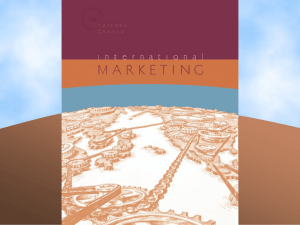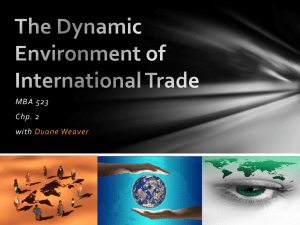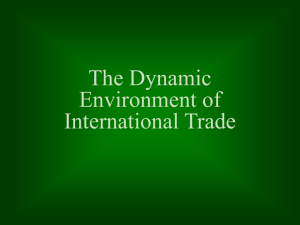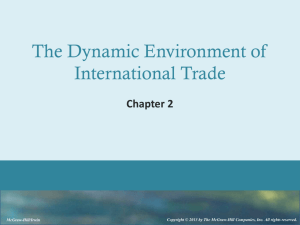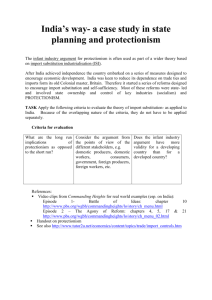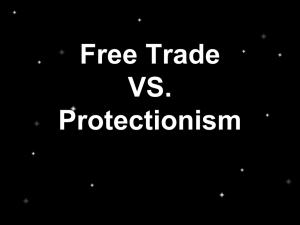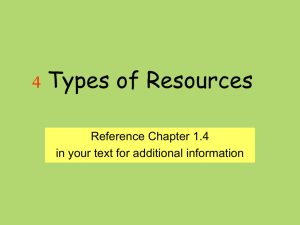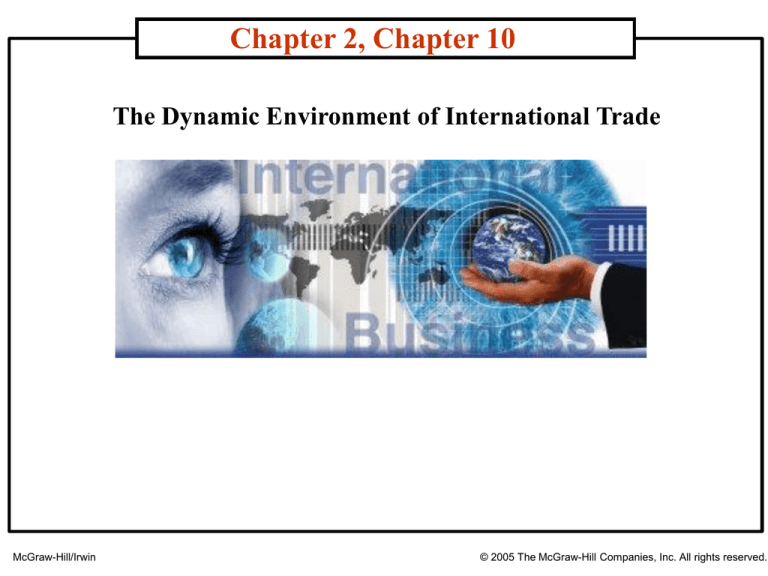
Chapter 2, Chapter 10
The Dynamic Environment of International Trade
McGraw-Hill/Irwin
© 2005 The McGraw-Hill Companies, Inc. All rights reserved.
Chapter Learning Objectives
1. The basis for the reestablishment of world trade
following World War II
2. The importance of balance-of-payment figures
to a country’s economy
3. The effects of protectionism on world trade
4. The seven types of trade barriers
Chapter Learning Objectives
5. The importance of GATT and the World Trade
Organization
6. Introduction to EU
7. The emergence of the International Monetary
Fund and the World Bank Group
The International Marketing Environment
Foreign Environment
(Uncontrollables)
7. Structure of
Distribution
1. Competition
Domestic environment
(Uncontrollables)
Environmental
uncontrollables
country market A
(Controllables) 1. Competition
2. Technology
Price
Product
Target
5. PoliticalEnvironmental
7
Market
uncontrollables
6. Geography and Legal
country
Promotion Place or 2 .Technology
Infrastructure
market B
Distribution
4.
Culture
Environmental
3. Economy
uncontrollables
5. Political3. ECONOMY
country
Legal
market C
4. Culture
U.S. Multinational in Europe - 1960’s
2-3
Fifteen years from now the
world’s third greatest industrial
power, just after the United
States and Russia, may not be
Europe, but American industry in
Europe.J.S. Servan Schreiber:
Le Defi American, 1967
What Happened?
How about now? Asia? Or China?
Irwin/McGraw-Hill
Copyright©2002 by The McGraw-Hill Companies, Inc. All rights reserve.
Introduction
Proliferation of trade and emergence of the global economy
Intensification of global competition
More emerging markets
Developments in technology allow communications with
global consumers and movement of goods
World Trade and U.S. Multinationals
1.
2.
3.
4.
5.
Rapid growth of underdeveloped countries
and new global marketing opportunities
Rising living standards have created
marketing opportunities for U.S. firms
Resistance over domination of U.S.
multinationals
Expropriation and domestication of U.S.
investments in Latin America
In the Europe, U.S. multinationals were
controlled tightly by protectionism laws
World Trade and U.S. Multinationals
1.
2.
3.
4.
5.
6.
Resurgence of competition from all over the
world challenged the supremacy of American
industry
Newly industrialized countries (NICs) such as
Brazil, Mexico, South Korea, Taiwan, Singapore,
and Hong Kong experienced rapid
industrialization
Economic power evenly distributed with growth
of MNCs from other countries (see Exhibit 2-2)
Establishment of the WTO
Integration of European Union countries
Creation of NAFTA, AFTA, and APEC
21st Century: The First Decade and Beyond
With exception of China, slower economic growth
in U.S. and other countries is currently evident.
Faster growth rates expected in developing
countries such as Brazil, China, India, Indonesia,
and Russia.
More trade expected in emerging markets, regional
trade areas, and the established markets in Europe,
Japan, and U.S.
Companies need to be more efficient, improve
productivity, expand global reach, and respond
quickly.
Greater growth in international sales expected by
smaller firms.
Balance of Payments
1.
2.
3.
4.
5.
When countries trade there are financial transactions among
businesses or consumers of different nations
Money constantly flows into and out of a country
The system of accounts that records a nation’s international
financial transactions is called its balance of payments (BP)
It records all financial transactions between a country’s firms,
and residents, and the rest of the world usually over a year
The BP is maintained on a double-entry bookkeeping system
Balance of Payments
The BP is the difference between receipts and payments
BP Receipts
BP Payments
•merchandise export sales.
•money spent by foreign tourists.
•transportation.
•payments of dividends and
interest from FDI abroad.
•new foreign investments in the
U.S.
•costs of goods imported.
•spending by U.S. tourists
overseas.
•new overseas investments.
•cost of foreign military and
economic aid.
Balance of Payments
The BP includes three accounts:
(1) current account—a record of
all merchandise exports, imports,
and services plus unilateral
transfers of funds;
(2) the capital account—a record of
direct investment, portfolio
investment, and short-term capital
movements to and from countries;
(3) the official reserves account—a record of exports and imports of gold,
increases or decreases in foreign exchange, and increases or decreases in
liabilities to foreign central banks;
Balance of Payments and Exchange Rate
1.
2.
3.
4.
If a country’s expenditures consistently exceed its income, its
standard of living falls
Its exchange rate vis-à-vis foreign monies declines
When foreign currencies can be traded for more dollars, U.S.
products are less expensive for foreign customers and exports
increase
Simultaneously foreign products are more expensive for U.S.
buyers and the demand for imported goods is reduced
Protectionism: Logic and Illogic
Countries use protectionist measures to shield a country’s markets from
intrusion by foreign competition and imports.
Arguments for Protectionism include:
1. maintain employment and reduce unemployment.
2. increase of business size, and
3. retaliation and bargaining.
4. protection of the home market.
5. need to keep money at home.
6. encouragement of capital accumulation.
7. maintenance of the standard of living and real wages.
8. conservation of natural resources.
9. protection of an infant industry
10. industrialization of a low-wage nation
11. national defense
Protectionism: Logic and Illogic
Arguments 9-11 above are considered valid for
protectionism
In general, protectionism contributes to industrial
inefficiency and makes a nation uncompetitive
Protectionism is implemented through the
imposition of trade barriers, which include tariff
barriers and non-tariff barriers
Six Types of Non-Tariff Barriers
(1) Specific Limitations on Trade:
1. Quotas
2. Import Licensing requirements
3. Proportion restrictions of foreign to
domestic goods (local content requirements)
4. Minimum import price limits
5. Embargoes
(2) Customs and Administrative Entry Procedures:
1. Valuation systems
2. Antidumping practices
3. Tariff classifications
4. Documentation requirements
5. Fees
Six Types of Non-Tariff Barriers
(3) Standards:
1. Standard disparities
2. Intergovernmental acceptances of testing
methods and standards
3. Packaging, labeling, and marking
(4) Government Participation in Trade:
1. Government procurement policies
2. Export subsidies
3. Countervailing duties
4. Domestic assistance programs
Six Types of Non-Tariff Barriers
(5) Charges on imports:
1. Prior import deposit subsidies
2. Administrative fees
3. Special supplementary duties
4. Import credit discriminations
5. Variable levies
6. Border taxes
(6) Others:
1. Voluntary export restraints
2. Orderly marketing agreements
Monetary Barriers
In addition to the Six Types of Non-Tariff Barriers, monetary barriers are
also used by countries
Three types of monetary barriers include:
1. Blocked currency: Blockage is accomplished by refusing
to allow importers to exchange its national currency for the
sellers’ currency.
2. Differential exchange rates: It encourages the
importation of goods the government deems desirable and
discourages importation of goods the government does not
want by adjusting the exchange rate. The exchange rate for
importation of a desirable product is favorable and viceversa
3. Government approval: In countries where there is a
severe shortage of foreign exchange, an exchange permit
to import foreign goods is required from the government
General Agreement on Tariffs
and Trade (GATT)
1.
2.
GATT created as an agency to serve as watchdog over world
trade and provide a process to reduce tariffs
GATT also provided a mechanism to resolve trade disputes
bilaterally
GATT covers three basic areas:
1. trade shall be conducted on a nondiscriminatory basis;
2. protection shall be afforded domestic industries
through customs tariffs, not through such commercial
measures as import quotas; and
3. consultation shall be the primary method used to solve
global trade problems.
3.
GATT now replaced by the World Trade Organization
World Trade Organization (WTO)
Unlike GATT,
is an institution, not an agreement
1. It sets many rules governing trade between its 132
members
2. WTO provides a panel of experts to hear and rule on
trade disputes between members, and, unlike GATT,
issues binding decisions
European Union (EU) – Economic
& Political Integration
• expansion – deepening and broadening
integration
– European Coal and Steel Community, 1951
• six countries (Belgium, France, Germany, Italy,
Luxembourg, the Netherlands)
– European Economic Community (EEC),
1957
• negative integration – absence of restrictions on
movement of workers, goods, services
• Denmark, Ireland and UK admitted, 1972
– European Union, 1993
• positive integration – actively fostering integration
– Maastricht Treaty, 1992
– Amsterdam Treaty, 1997
• 15 members currently
– Greece (1986), Spain (1986), Portugal (1986),
Austria (1995), Finland (1995), Sweden (1995)
– 10 candidate countries (Bulgaria, Czech Republic,
Estonia, Cyprus, Latvia, Lithuania, Hungary, Malta,
Poland, Romania, Slovenia, Slovakia, Turkey)
European Union (EU) –
Institutions
• legislative – shared legislative
powers
• Council of the European Union
– ministers and heads of state of member
countries
• European Parliament
– direct election
• executive – European Commission
– President and commissioners
appointed by member states
– confirmed by European Parliament
• judiciary – Court of Justice
European Union (EU) –
Economic Integration
• single market
– free movement of people, capital (investment), goods
and services
• monetary union
• the Euro
– comes into existence January, 1999
– banknotes and coins in circulation, January 2002
– national banknotes and coins withdrawn from use (February
2002)
• common labor market
• Schengen Agreement, 1985
European Union (EU) –
Political Integration
• political integration
– common political institutions
• e.g. European Parliament
– common European citizenship
• freedom of movements
• fundamental rights
• civil and political rights
– common social citizenship (limited)
• access to social programs in other countries
– common currency
• money traditionally symbol of sovereignty
• requires integrated monetary policy
Association of Southeast Asian Nations
(ASEAN)
Brunei
Singapore
Indonesia
Thailand
Laos
Vietnam
Malaysia
Myanmar
Philippines
Association of Southeast Asian Nations
(ASEAN) + 3
Brunei
Singapore
Indonesia
Thailand
Laos
Vietnam
Malaysia
Japan
Myanmar
S. Korea
Philippines
China
Asia-Pacific Economic Cooperation (APEC)
Australia
Japan
Philippines
Brunei
South Korea
Russia
Canada
Malaysia
Singapore
Chile
Mexico
Taiwan
China
New Zealand
Thailand
Hong Kong
Papua New Guinea
U.S.A.
Indonesia
Peru
Vietnam
North American Free-Trade Area (NAFTA)
Canada
United States
Mexico
The International Monetary Fund (IMF)
1.
2.
3.
4.
IMF was created to assist nations in becoming and remaining
economically viable
It assists countries that seek capital for economic development
and restructuring
IMF loans come with stipulations that borrowing countries slash
spending and impose controls to curb inflation
It helps maintain stability in the world financial markets
Objectives of the IMF include:
1. stabilization of foreign exchange rates
2. establish convertible currencies to
facilitate international trade
3. lend money to members in financial
trouble
World Bank Group (WBG)
The goal of WBG is to reduce poverty and the improvement of
living standards by promoting sustainable growth and investment
in people.
The functions of the WBG include:
1.
2.
3.
4.
5.
lending money to countries to finance development projects in
education, health, and infrastructure;
providing assistance for projects to the poorest developing countries;
lending directly to the private sector in developing countries with
long-term loans, equity investments, and other financial assistance;
provide investors with investment guarantees against
“noncommercial risk,” so developing countries will attract FDI; and
provide conciliation and arbitration of disputes between governments
and foreign investors
Protests Against Global Institutions
In 1999 “anti-capitalist protestors” complained against the WTO, and IMF,
over the unintended consequences of globalization that include:
1.
2.
3.
4.
5.
environmental concerns
worker exploitation and domestic job losses
cultural extinction
higher oil prices, and
diminished sovereignty of nations

